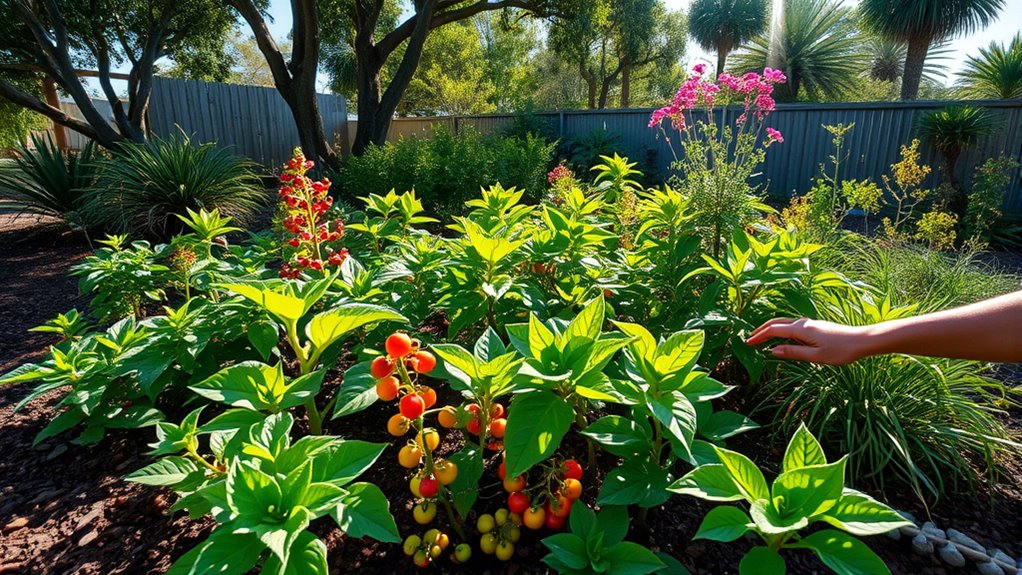Growing native Australian edibles in your backyard connects you to the land’s unique landscape and sustainable traditions. You can propagate plants like finger lime and wattleseed using seeds or cuttings, while enriching your soil with compost and native-specific conditioners to boost growth. Native plants are resilient, requiring less intervention, and support local biodiversity. By caring for these plants, you create a thriving, eco-friendly garden that offers a delicious and authentic bush tucker experience—discover more about cultivating these native treasures below.
Key Takeaways
- Propagate native edible plants like finger lime and wattleseed using seeds, cuttings, or division for healthy garden growth.
- Enrich native soil with organic matter such as compost and mulch to promote nutrient uptake and plant resilience.
- Choose well-draining, nutrient-poor soils mimicking natural habitats to support native bush tucker plants.
- Support sustainable growth by understanding plant habits, maintaining soil health, and attracting native pollinators.
- Cultivate a native edible garden to connect with Australia’s landscape, promote biodiversity, and enjoy fresh bush tucker in your backyard.

Bush tucker gardening offers a sustainable way to connect with Australia’s native landscape while providing fresh, edible plants. By cultivating these plants in your backyard, you not only enjoy a unique culinary experience but also contribute to preserving native biodiversity. One of the key steps in establishing a thriving bush tucker garden is understanding plant propagation. Many native species, such as finger lime or wattleseed, can be propagated through cuttings, seeds, or division. Propagating plants yourself allows you to select healthy specimens and guarantee the genetic quality of your garden. For successful propagation, it’s vital to prepare your planting material correctly—taking cuttings from healthy, disease-free plants and treating them with rooting hormone can increase your success rate. Using native seeds requires patience and the right techniques, such as scarification or stratification, to encourage germination. As your plants grow, practicing effective soil enrichment becomes imperative. Australian native plants often thrive in well-draining, nutrient-poor soils, but supplementing your soil with organic matter boosts growth and resilience. Incorporate compost, aged mulch, or native-specific soil conditioners to improve soil structure and fertility. This not only supports healthy root development but also reduces the need for synthetic fertilizers, making your garden more sustainable. When enriching your soil, avoid overwatering, as many native species are adapted to drought conditions and can suffer from root rot if kept consistently wet. Instead, focus on creating a balanced environment that mimics their natural habitat. Additionally, understanding the importance of high-quality projectors and their impact on plant growth can be beneficial for indoor native plant cultivation. As your native plants establish, you’ll notice their unique growth habits and resilience, making garden maintenance easier and more rewarding. Regularly checking soil health, adjusting watering schedules, and adding organic amendments foster an environment where your edible native plants can flourish. Additionally, practicing plant propagation and soil enrichment together helps create a self-sustaining ecosystem that requires less intervention over time. This approach encourages the development of a diverse garden, attracting native pollinators and beneficial insects. As you expand your bush tucker garden, you’ll find that understanding how to propagate native plants and enrich your soil leads to healthier, more productive plants. Plus, it deepens your connection to Australia’s landscape, allowing you to harvest fresh, native ingredients right from your backyard. Growing native edibles isn’t just about the food; it’s about embracing a sustainable lifestyle that respects the environment while enjoying the bounty of Australia’s unique flora. With patience and care, your bush tucker garden will become a vibrant, resilient space that offers both culinary delights and ecological benefits.
Frequently Asked Questions
Which Native Plants Are Best for Beginner Gardeners?
If you’re new to gardening, start with native plants that are easy to grow and identify. Focus on edible plant identification and native plant propagation, choosing hardy options like warrigal greens, native mint, or bush tomatoes. These plants thrive with minimal care and are perfect for beginners. They also help you learn the basics of native gardening while enjoying delicious, edible rewards from your backyard.
How Do I Prevent Pests on Bush Tucker Plants?
Pest management can feel like a constant battle, but natural repellents offer an eco-friendly solution. Start by encouraging beneficial insects like ladybugs and using companion planting to deter pests. You can also apply homemade sprays with garlic or chili to keep unwanted visitors away. Regularly inspect your native plants, remove pests early, and create a healthy, balanced garden environment. This proactive approach helps protect your bush tucker plants naturally and effectively.
What Soil Conditions Do Native Edibles Prefer?
You should aim for well-draining soil with a slightly acidic to neutral soil pH, typically between 5.5 and 7.0. Native edibles thrive in soil rich in organic matter, so adding compost or aged manure helps improve fertility and moisture retention. Avoid overly sandy or heavy clay soils, as they can hinder root development. Regularly test your soil to maintain ideal conditions, ensuring your plants stay healthy and productive.
Can Bush Tucker Plants Be Grown in Containers?
Yes, you can grow bush tucker plants in containers. Use companion planting to enhance growth and protect your plants from pests. Make sure to water frequently, especially in warmer weather, but avoid overwatering. Choose a well-draining soil mix suited for native edibles, and place your containers where they’ll get plenty of sunlight. Regular watering and mindful companion planting help your native plants thrive in a container garden.
Are There Any Legal Restrictions on Harvesting Native Plants?
You should be aware that harvesting native plants can be restricted by wildlife conservation laws and land access regulations. These rules aim to protect ecosystems and prevent overharvesting. Always check local laws before collecting, as some areas require permits or prohibit removal altogether. Respect landownership boundaries and conservation efforts to make sure you’re supporting biodiversity and sustainable use of native plants.
Conclusion
By embracing bush tucker gardening, you’re planting a treasure chest of native flavors right in your backyard. It’s like opening a door to Australia’s wild pantry, where every leaf and berry tells a story. With a little care, you’ll nurture a garden that’s not only sustainable but bursting with flavors that connect you to the land. So go ahead—dig in and let your garden be a gateway to nature’s hidden buffet.
Mary is a passionate writer who brings creativity and a fresh perspective to our team. Her words have the power to captivate and inspire, making her an essential contributor to our content. Mary’s commitment to storytelling and dedication to promoting Indigenous culture ensures that her work touches the hearts of our readers. We’re fortunate to have her as part of our team.










